编著:梁守渝 Mri D. Ngo 来源:中国散手快摔 演示:梁守渝 Chapter 2 Basic Training 基本訓練 2-I. Introduction Basic training is the root and foundation of San Shou Kuai Jiao. This training teaches the fundamental skills and principles of the art. You need to understand and master the basic skills in order to apply San Shou Kuai Jiao techniques effectively. Also, basic training helps you build a solid foundation for further advancement. An effective San Shou Kuai Jiao technique requires whole-body coordination, including hands, body movement, footwork (stepping), and falling. Basic training devel-ops this coordination, along with good posture and good body control. Furthermore, basic training will help you to improve your strength,speed, endurance and technical accuracy. The training methods intro-duced in this chapter are essential for proficiency in San Shou Kuai Jiao.You should learn and master these basics before practicing the San Shou Kuai Jiao techniques in later chapters. In this chapter, we will introduce some warm up exercises, stances,footwork, beginning entering training, and falling techniques. 2-2. Warm Up Exercises The warm up is an important part of every workout. Warm up will help you to stimulate your joints, muscles, and the central nervous sys-tem of your body. Also, warm up exercises will help you improve your flexibility and strengthen muscles and tendons in your body. Your body should be warm and loose before you start your practice. In this section, we will introduce some typical exercises. Practitioners can add their own exercises to fit their personal needs. 1- Waist Rotation 小涮腰 For warming up and loosening the waist muscles. Training Method: Stand with your legs shoulder-width apart and place both hands on top of your head. Rotate your waist clockwise repeatedly and then counterclockwise (Figures 2-1 t02-5). 2- Large Waist Rotation 大涮腰 Increases waist flexibility and muscle strength. Training Method: Stand with both legs shoulder width apart. Extend both arms to the sides. Bend the torso towards your left leg (Figure 2-6) and make large, sweeping circles from left to right and back to the starting position. Be sure to make complete circles and empha-size moving from the waist. The arms should be loose and extended and the circular motion should be smooth and contin-uous (Figures 2-7 and 2-8 and 2-9). Repeat this exercise as many times as you want, and then change to the opposite direction. 3.Front Leg Press正壓腿 Increases the flexibility and strength of the leg muscles and ten-dons. Training Method: Put your right foot on a stretch bar higher than your waist, with your body facing forward. Straighten both the leg on the bar and the leg on the ground. With a straight back, bend forward towards your right foot and try to touch your chest to your leg. (Figure 2-10). Repeat 20 t030 times and then change legs. 4. Sideways Leg Press側壓腿 Increases the flexibility and strength of the leg muscles and ten-dons. Also helps to increase the turning angle of the hip joints. Training Method: Put your right foot on a stretch bar higher than your waist. Your torso should face sideways. Keep both legs straight and press your body sideways toward your right. Try to touch your right leg with your right shoulder (Figure 2-11). Repeat 20 t030 times and then change legs. 5. Backward Leg Press后壓腿 Increases the flexibility and strength of the back and legs. Training Method: Put your left foot on a stretch bar higher than your waist. The knee should be bent and your back should face the bar. Keep your right leg straight, keep your head up and press your body backward (Figure 2-12). Repeat 20 t030 times and then change legs. 6. Leg Splits 劈叉 Increases the flexibility and strength of the leg muscles and ten-dons. Training Method: Keep both legs straight, one in front and one in back. Use one hand on either side of the body for support. Press downward so that your legs touch the floor. Make sure to keep your hip straight and your torso facing the front leg (Figure 2-13). Repeat 20 t030 times, and then switch sides. To avoid injury, start slow- ly and gradually increase both the repetitions and the depth of the split. 7. Tendon Stretching 伸筋 Increases the flexibility of the back and legs Training Method: Stand with both legs straight and shoulder-width apart. Lock your fingers together and extend the arms forward at shoulder height. Then raise your hands above your head. From this posi-tion, bend forward from the waist until your hands touch the floor. Staying bent, wrap your arms around your calves and pull your head towards your shins. The legs must remain straight at all times. Stay in this position for 10 t030 seconds and repeat as many times as you like (Figures 2-14 t02-17). 8. Diagona~ Stretching 合臥襠 Increases the flexibility and strength of the waist and legs Training Method: Open both legs wider than your shoulders. Keep your torso straight and bend forward from the waist. Try to touch the floor with your forehead while keeping your legs straight. (Figure 2-18). Then move to the right leg and then the left leg. Try to bringyour forehead to your foot. Both hands should hold the leg(Figures 2-19 and 2-20). 9. Front Kick正踢腿 Helps to improve flexibility, leg movement, and body stability. Training Method: Stand with one foot forward,both knees slightly bent, and the heel of the rear foot slight-ly lifted. Stretch both arms to the sides at shoulder height.Kick upward as high as you can with the rear leg. The kicking leg must keep straight with the toes locked in. Don't bend your back when kicking. The heel of the supporting leg should not leave the ground (Figure 2-21). Repeat the kick as many times as you like and then change sides. IO. Side Kick侧踢腿 Helps to improve flexibility, leg movement, and body stability Training Method: Stand sideways and extend both hands out to the sides (Figure 2-22). Cross your left foot in front of your right (Figure 2-23) and then kick with your right leg sideways and up towards your right shoulder. Keep the kicking leg straight and lock in the toes.Simultaneously, bring your right hand down to waist height and your left hand in front and above your head (Figure 2-24). Bring the kicking leg straight down. Repeat the exercise as many time as you like, then change legs. 1I. Outside Crescent Kick a摆蓮腿 Increases the flexibility in the hip joints. Training Method: Stand with the legs shoulder width apart and extend both hands out to the sides. Turn your body slightly to your left and sweep the right leg upward from the left to the right across your face and downward to your right. Keep your kicking leg straight and lock your toes (Figures 2-25 and 2-26). Remember to use the waist to generate power. Repeat as many times as you like and then switch legs. 12. Inside Crescent Kick 裡合腿 Increases the flexibility in the hip joints Training Method: Stand with the legs shoulder width apart and extend both hands out to the sides. Sweep your right leg upward and out to the right and then across to the left. Keep the kicking leg straight and lock in your toes (Figures 2-27 and 2-28).Remember to use the waist generate power. Repeat as switch legs. 2-3. San Shou Kuai Jiao Basic Stances and Leg Training散手快腿功本 Basic stance training and basic leg training are important in San Shou Kuai Jiao. They include fundamental techniques specially designed for San Shou Kuai Jiao. It is very common that basic stances and basic legs techniques are blended together in the training. Stance training will help you develop the correct postures for San Shou Kuai Jiao applica-tions. Basic leg training will help you to improve the mobility of the legs and body movement. Combining stances and leg training is an effective way to gain good body control, strength, balance, and whole-body coor- dination. 1- Back Hook跪腿 For leg hooking and supporting leg stability training Training Method: Stand with both legs shoulder width apart, both hands on your waist (Figure 2-29). Hook your right leg upward from behind with the sole of the foot facing up (Figure 2-30). Keep the s upport-ing leg stable and repeat the exercise as many times as you like,and then switch legs. 2- Pulling Out the Leg 抽腿 Increases leg mobility and strength. For example: when your leg is pinched by your opponent, you can easily pull it out for a coun-terattack. Training Method: Sit down with your left leg crossed and on top of your right(Figure 2-31). Stand up and lift your right leg with the knee bent(Figure 2-32). Then step to the right. Then lift your left leg in the same manner, cross in front of the right and squat down (Figure2-33). Switch right and left repeatedly. 3. Squat Down Hook Kicking 蹲踢 For stability training and hooking or kicking an opponent's heel. Training Method: Squat down in Horse Stance (Figure 2-34), then kick upwards to your left with the right leg. Pull your toes back, keep the leg straight, and let the kicking leg's heel brush the floor on its way up. Pull both hands from left to right to create symmetry power(Figure 2-35). Keep the supporting leg bent throughout the kick. Alternate with both legs to repeat the exercise. 4. Turning in Bow Stance大转腳 Trains the turning, twisting and exploding power of the legs and hips. Training Method: Start in Right Bow Stance (Figure 2-36) and turn your body, using both heels, to Left Bow Stance. While you are turning, the right heel pushes into the ground to create the explosive twisting power of the legs and hips. Repeat the exercise by switching from left to right. 5. Extending the Body長腰 Trains the combined power of body turning and extending the power of the body and arms to drag an opponent or break free from an opponent's grab. Training Method: Start in Left Bow Stance with the left fist close to the waist. Your right arm extends foward with the right fist closed (Figure 2-37).Turn your body to the right on both heels. While you are turning,the left heel pushes into the ground to create the explosive twist-ing power. Simultaneously, pull the right hand back to your waist, extend the left hand as far forward as you can and turn your body to the right. Look back all the way to your right (Figure 2-38).Repeat the same exercise in the opposite direction for the left side. Change from side to side as many times as you like. 6. Sitting and Crossing Leg For leg flexibility and strength and body balance. Training Method: Stand with both legs shoulder width apart (Figure 2-39). Pivot180 degrees to your right on your right heel and left toes and lower your body so that your right leg will be on top of the left(Figure 2-40). Twist back up to a standing position and repeat the same exercise in the opposite direction (Figure 2-41). Continue to pivot from side to side as many times as you like. 7.Jumping Training跳八扇 For speed, body mobility, and coordination training30 Training Method: Stand with feet shoulder width apart (Figure 2jump up and land in a Left Bow Stance. Simultaneously, twist your body to your left, pull the left hand back to the waist, and extend the right hand in front of your body (Figure 2-43). Both legs jump up from Left Bow Stance to the original position (Figure2-44). From the original position, both legs jump up and land in a Horse Stance (Figure 2-45). From Horse Stance you can repeat the exercise for Right Bow Stance. 8. Coiling Leg盤腿 Trains you to lift your leg quickly and easily. Usually used to escape low kicks or lower leg controlling techniques. This exer-cise will also help to loosen up your hip joint. Training Method: Stand with both legs shoulder width apart. Shift your body weight to your left leg and lift your right leg upwards at least as high as your knee (Figure 2-46). Put your right leg down and repeat with your left leg. Alternate both legs as many times as you like. 9. Stationary Coiling Leg盤腿耗樁 For leg and knee strength, balance, and stretching the hip joints. Training Method: Put both hands on your waist and squat down. Put your left leg on top of your right knee. Stay in this position for at least l t05 minutes (Figure 2-47). Change to the other leg and repeat the exercise. Keep your back straight and slowly increase the length of time you can hold this position. 10. Coiling Leg and Kicking Backward盤腿扔空 For leg hooking and blocking techniques. Training Method: Start from the stationary coiling leg position with the right leg on top and both arms extended to the sides (Figure 2-48). Twist your body to your left on the ball of your left foot, swing your right leg down and backward, then hook the leg up as high as you can,bending the knee and pointing the toe. Simultaneously, pull your left hand back to the waist and the right hand upward then down-ward to your left so that both arms move in a large circular motion. Bend forward, keep your chin tucked in, and look to your left (Figure 2-49). Change to the other leg and repeat this exercise in the opposite direction. Always keep your supporting leg slight-ly bent so you will not lose your balance when kicking backward. 2-4. Basic San Shou Kuai Jiao Entering Training快跤基本步法 In order to apply San Shou Kuai Jiao techniques effectively, you need to have proper footwork (stepping) and stances. All the San Shou Kuai Jiao techniques require certain entering methods to complete the throws. But keep in mind that the entering skill is built on the foundation of the stances and footwork methods already introduced. Footwork allows you to control your body balance and many San Shou Kuai Jiao techniques require proper stepping to complete the throw. Without a proper way to get close to your opponent, your San Shou Kuai Jiao techniques will not be effective. Thus, entering skills are very important. Although some San Shou Kuai Jiao techniques do not require you to get very close to your opponent to throw him, a smooth and quick entering move will give your opponent no time to react and will put you at an advantage. In this section, we will introduce a few entering methods commonly used in San Shou Kuai Jiao. You can practice them solo or with a partner. 1. Front Cross Step Entering 蓋步入 Training Method: Stand with your feet shoulder width apart and squat down slight-ly. Lift your right foot and cross it in front of your left foot (Figures 2-50 and 2-51). Pivot your body to the left on the balls of the feet and thrust your right hip backward. Keep your body pos-ture low (Figure 2-52). Spring up on both of your knees and keep the right hip driving upward, while simultaneously bending for-ward to your left. Your left hand should pull downward then upward to the back and your right hand should pull downward to your left to trace a large circular motion. Keep your chin tucked in and look back to your left (Figure 2-53). Repeat the exercise as many times as you like and switch to the other side and repeat the movements in the opposite direction. 2-. Back Cross Step Entering 背入 Training Method: This entering technique is almost exactly the same as the previ-ous technique Front Cross Step Entering except that from the starting position, the left foot steps behind the right foot. The rest of the movements are the same. Train both sides as many times as you want (Figures 2-54 t02-56). 3. Fast Entering 快入 Training Method: This Entering technique is almost exactly the same as the previ-ous techniques Front Cross Step Entering and Back Cross Step Entering except that from the starting position, you don't step in front or step around behind. Instead you will jump and turn 180degrees to the left and land with your back facing your opponent in a ready-to-throw posture. After landing, your right hip should thrust against your opponent's lower abdomen. The rest of movements are executed in the same way (Figures 2-57 t02-59). Train both sides as many times as you like. 4. Carry Entering攜入 Training Method: In this technique, you can apply the footwork used in Front Cross Step Entering,Back Cross Step Wntering,Back Cross Step Wntering and Fast Entering. The only difference in this technique is that you bend straight tor-ward instead of ending left or ringt(Figure2-60)., 2-5. Falling跌法 Training in San Shou Kuai Jiao involves a lot of throwing or being thrown by a partner. In some circumstances, you may need to fall to the ground purposely to execute certain throwing techniques. Therefore, one of the very first skills you need to learn is how to fall. It is of utmost importance that you know how to fall correctly and safely. Being able to fall correctly in any position will help you to prevent injuries. It is also an effective way to train bodily awareness, coordination, and quickness. Another benefit of having good falling skills is that once you have learned and mastered the skill of falling, you will be more relaxed and confident during practice or in a fight For all falling training a safety mat is recommended. 1. On Ground Body Position 滾動倒地法 Training Method: This is a very typical body position used for self protection when you fall. Before you land on the ground, tuck in your chin, con- tract your body so that the torso is rounded, bend your arms, and use your hands to cover both sides of your head. Land on your side to protect the spine. At the moment of impact, tense up your body by holding your breath to prevent internal organ injury from the force of the landing (Figure 2-61). 2. Rolling Forward 搶背 Training Method: Start with the right foot as the leading foot. Place your right arm at the side of your right foot with fingers pointed inward, and shoulder tucked in. Place your left arm in front of your body, keep your chin tucked in, and the right arm slightly bent with the elbow pointing outwards (Figure 2-62). Roll forward over your right arm, then your shoulder, and then diagonally across the back (Figures 2-63 and 2-64). Repeat the same movement for the left side. 3. Falling Sideways侧倒 Training Method: Start in a squatting position and fall sideways to your right. Before your body makes contact with the ground, keep your right arm bent with fingers pointing inward and use the arm to absorb the shock. Keep your chin tucked in, coil your body, and pull up your knees. Land on your right side (Figures 2-65 and 2-66). Change to the other side and repeat. 4。 Falling Forward 撐地倒 Training Method: A). Kneeling Position Start in a kneeling position with both arms in front of your body and slightly bent(Figure 2-67).Keep your head up and start to fall forward. The palms should make contact first, followed by the forearms to absorb the shock of the fall (Figure 2-68). B). Standing Position The degree of difficulty in this position is much greater than the Kneeling Position. You may want to start with the Kneeling Position first, then practice from a Squatting Position and then Standing. Keep your head up and arms in front of the body. Make contact with the palms and then the forearms (Figures 2-69 and 2-70). 5.Coiling Leg and Falling Sideways屈体盤腿側倒 Training Method: Coil your right leg upwards, bend your right arm with your palm facing down, bend your left arm in front of the body, and slightly bend your left leg (Figure 2-71). Fall to the right. The outside of your right leg near the calf should make contact first, then the outside of the thigh. Also use both palms and the inside right forearm to absorb the shock (Figures2-72 and 2-73). At the moment of contact, hold your breath and tense up your body. This will help to prevent internal organ damage from the force of the impact. 6.Fat]in口Backward后倒后背著地 Training Method: This is a difficult and challenging falling technique. When prac-ticing this falling method, start in a sitting position first, then a squatting position, and finally standing. Also, when practicing from a standing position, you may ask your partner to spot you until you have the confidence to practice on your own. Be safe. The falling movement is the same for all positions. We will demonstrate it from a standing position. Stand up straight with your feet shoulder width apart. Extend both arms to sides as you begin to fall backward(Figure2-74). As you fall, keep your chin tucked in. Just as the upper part of your back touches the ground, slap the ground with the insides of both arms and thrust your stomach forward(Figure 2-75).Hold your breath and tense your muscles to help prevent injury. 编著:梁守渝 Mri D. Ngo 来源:中国散手快摔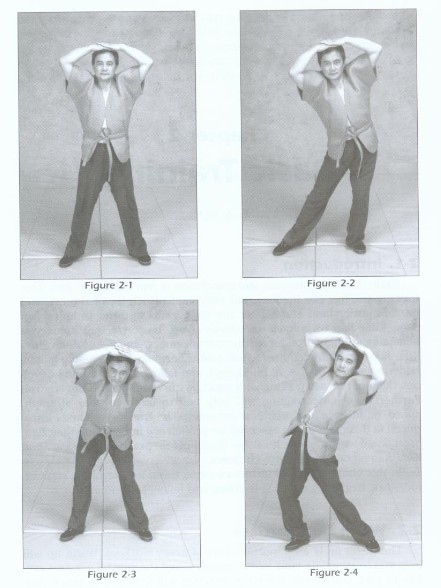
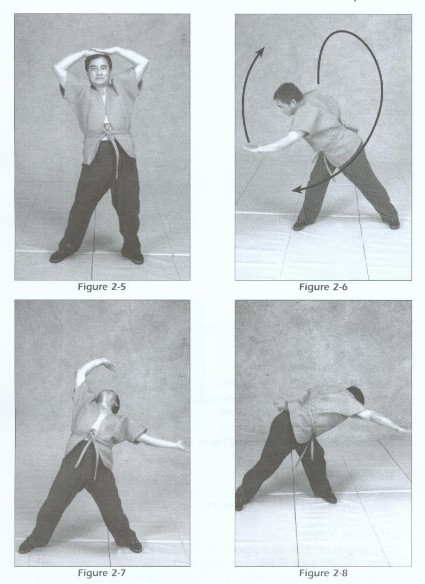

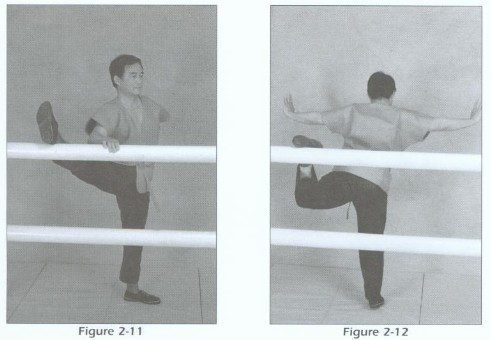
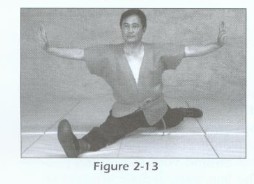
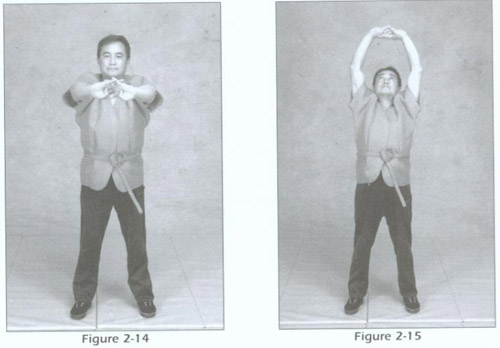

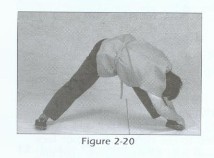
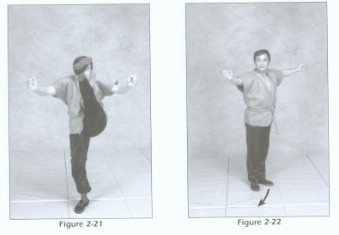
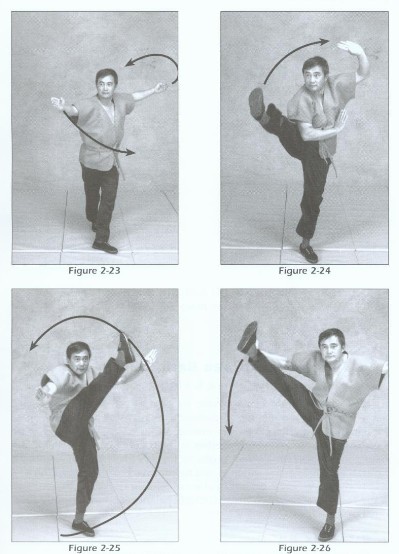

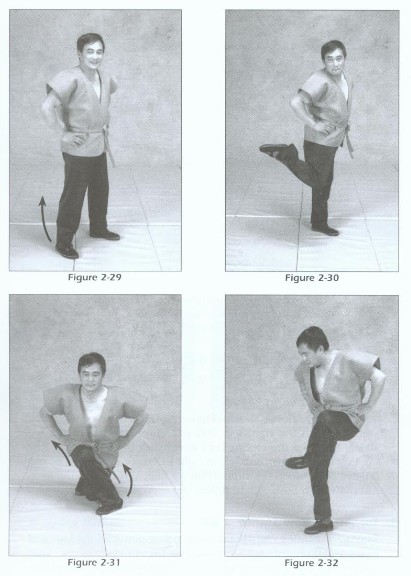


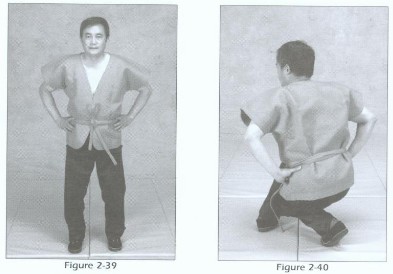


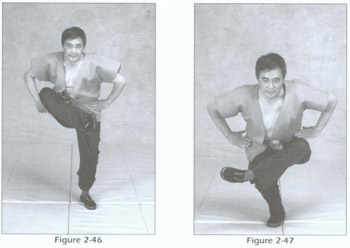

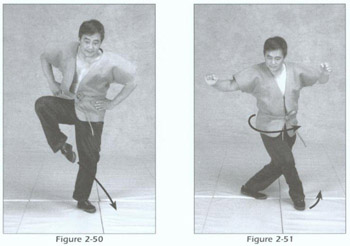
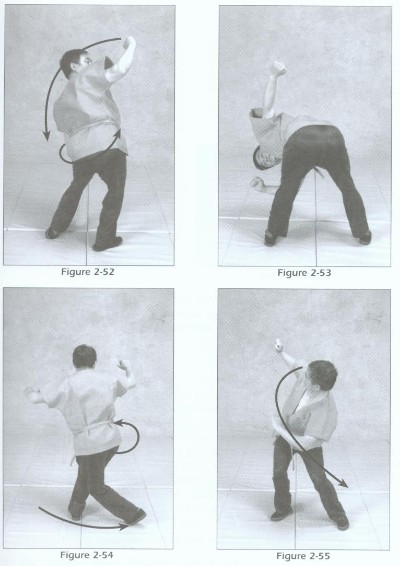

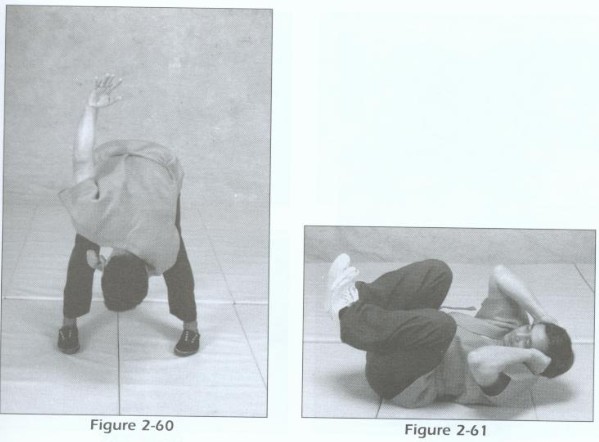




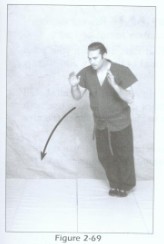
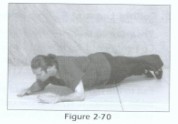
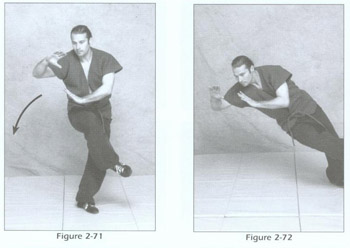
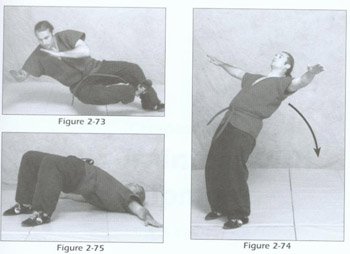
 Training Method:Stand with your legs shoulder-width apart and place both hands on top of your head. Rotate your waist clockwise repeatedly and then counterclockwise (Figures 2-1 t02-5).2- Large Waist Rotation 大涮腰Increases waist flexibility and muscle strength.
Training Method:Stand with your legs shoulder-width apart and place both hands on top of your head. Rotate your waist clockwise repeatedly and then counterclockwise (Figures 2-1 t02-5).2- Large Waist Rotation 大涮腰Increases waist flexibility and muscle strength. Training Method:Stand with both legs shoulder width apart. Extend both arms to the sides. Bend the torso towards your left leg (Figure 2-6) and make large, sweeping circles from left to right and back to the starting position. Be sure to make complete circles and empha-size moving from the waist. The arms should be loose and extended and the circular motion should be smooth and contin-uous (Figures 2-7 and 2-8 and 2-9). Repeat this exercise as many times as you want, and then change to the opposite direction.
Training Method:Stand with both legs shoulder width apart. Extend both arms to the sides. Bend the torso towards your left leg (Figure 2-6) and make large, sweeping circles from left to right and back to the starting position. Be sure to make complete circles and empha-size moving from the waist. The arms should be loose and extended and the circular motion should be smooth and contin-uous (Figures 2-7 and 2-8 and 2-9). Repeat this exercise as many times as you want, and then change to the opposite direction.  3.Front Leg Press正壓腿Increases the flexibility and strength of the leg muscles and ten-dons.Training Method:Put your right foot on a stretch bar higher than your waist, with your body facing forward. Straighten both the leg on the bar and the leg on the ground. With a straight back, bend forward towards your right foot and try to touch your chest to your leg.(Figure 2-10). Repeat 20 t030 times and then change legs. 4. Sideways Leg Press側壓腿Increases the flexibility and strength of the leg muscles and ten-dons. Also helps to increase the turning angle of the hip joints.Training Method:Put your right foot on a stretch bar higher than your waist. Your torso should face sideways. Keep both legs straight and press your body sideways toward your right. Try to touch your right leg with your right shoulder (Figure 2-11). Repeat 20 t030 times and then change legs. 5. Backward Leg Press后壓腿 Increases the flexibility and strength of the back and legs.
3.Front Leg Press正壓腿Increases the flexibility and strength of the leg muscles and ten-dons.Training Method:Put your right foot on a stretch bar higher than your waist, with your body facing forward. Straighten both the leg on the bar and the leg on the ground. With a straight back, bend forward towards your right foot and try to touch your chest to your leg.(Figure 2-10). Repeat 20 t030 times and then change legs. 4. Sideways Leg Press側壓腿Increases the flexibility and strength of the leg muscles and ten-dons. Also helps to increase the turning angle of the hip joints.Training Method:Put your right foot on a stretch bar higher than your waist. Your torso should face sideways. Keep both legs straight and press your body sideways toward your right. Try to touch your right leg with your right shoulder (Figure 2-11). Repeat 20 t030 times and then change legs. 5. Backward Leg Press后壓腿 Increases the flexibility and strength of the back and legs.
 Training Method:Put your left foot on a stretch bar higher than your waist. The knee should be bent and your back should face the bar. Keep your right leg straight, keep your head up and press your body backward (Figure 2-12). Repeat 20 t030 times and then change legs. 6. Leg Splits 劈叉Increases the flexibility and strength of the leg muscles and ten-dons.Training Method:Keep both legs straight, one in front and one in back. Use one hand on either side of the body for support. Press downward so that your legs touch the floor. Make sure to keep your hip straight and your torso facing the front leg (Figure 2-13). Repeat20 t030 times, and then switch sides. To avoid injury, start slow- ly and gradually increase both the repetitions and the depth of the split.
Training Method:Put your left foot on a stretch bar higher than your waist. The knee should be bent and your back should face the bar. Keep your right leg straight, keep your head up and press your body backward (Figure 2-12). Repeat 20 t030 times and then change legs. 6. Leg Splits 劈叉Increases the flexibility and strength of the leg muscles and ten-dons.Training Method:Keep both legs straight, one in front and one in back. Use one hand on either side of the body for support. Press downward so that your legs touch the floor. Make sure to keep your hip straight and your torso facing the front leg (Figure 2-13). Repeat20 t030 times, and then switch sides. To avoid injury, start slow- ly and gradually increase both the repetitions and the depth of the split. 7. Tendon Stretching 伸筋Increases the flexibility of the back and legsTraining Method:Stand with both legs straight and shoulder-width apart. Lock your fingers together and extend the arms forward at shoulder height. Then raise your hands above your head. From this posi-tion, bend forward from the waist until your hands touch thefloor. Staying bent, wrap your arms around your calves and pull your head towards your shins. The legs must remain straight at all times. Stay in this position for 10 t030 seconds and repeat as many times as you like (Figures 2-14 t02-17). 8. Diagona~ Stretching 合臥襠Increases the flexibility and strength of the waist and legsTraining Method:Open both legs wider than your shoulders. Keep your torso straight and bend forward from the waist. Try to touch the floor with your forehead while keeping your legs straight. (Figure 2-18). Then move to the right leg and then the left leg. Try to bringyour forehead to your foot. Both hands should hold the leg(Figures 2-19 and 2-20).9. Front Kick正踢腿 Helps to improve flexibility, leg movement, and body stability.
7. Tendon Stretching 伸筋Increases the flexibility of the back and legsTraining Method:Stand with both legs straight and shoulder-width apart. Lock your fingers together and extend the arms forward at shoulder height. Then raise your hands above your head. From this posi-tion, bend forward from the waist until your hands touch thefloor. Staying bent, wrap your arms around your calves and pull your head towards your shins. The legs must remain straight at all times. Stay in this position for 10 t030 seconds and repeat as many times as you like (Figures 2-14 t02-17). 8. Diagona~ Stretching 合臥襠Increases the flexibility and strength of the waist and legsTraining Method:Open both legs wider than your shoulders. Keep your torso straight and bend forward from the waist. Try to touch the floor with your forehead while keeping your legs straight. (Figure 2-18). Then move to the right leg and then the left leg. Try to bringyour forehead to your foot. Both hands should hold the leg(Figures 2-19 and 2-20).9. Front Kick正踢腿 Helps to improve flexibility, leg movement, and body stability.
 Training Method:Stand with one foot forward,both knees slightly bent, and the heel of the rear foot slight-ly lifted. Stretch both arms to the sides at shoulder height.Kick upward as high as you can with the rear leg. The kicking leg must keep straight with the toes locked in. Don't bend your back when kicking. The heel of the supporting leg should not leave the ground (Figure 2-21). Repeat the kick as many times as you like and then change sides.
Training Method:Stand with one foot forward,both knees slightly bent, and the heel of the rear foot slight-ly lifted. Stretch both arms to the sides at shoulder height.Kick upward as high as you can with the rear leg. The kicking leg must keep straight with the toes locked in. Don't bend your back when kicking. The heel of the supporting leg should not leave the ground (Figure 2-21). Repeat the kick as many times as you like and then change sides. IO. Side Kick侧踢腿Helps to improve flexibility, leg movement, and body stabilityTraining Method:Stand sideways and extend both hands out to the sides (Figure 2-22). Cross your left foot in front of your right (Figure 2-23) and then kick with your right leg sideways and up towards your right shoulder. Keep the kicking leg straight and lock in the toes.Simultaneously, bring your right hand down to waist height and your left hand in front and above your head (Figure 2-24). Bring the kicking leg straight down. Repeat the exercise as many time as you like, then change legs.1I. Outside Crescent Kick a摆蓮腿Increases the flexibility in the hip joints.Training Method:Stand with the legs shoulder width apart and extend both hands out to the sides. Turn your body slightly to your left and sweep the right leg upward from the left to the right across your face and downward to your right. Keep your kicking leg straight and lock your toes (Figures 2-25 and 2-26). Remember to use the waistto generate power. Repeat as many times as you like and then switch legs.
IO. Side Kick侧踢腿Helps to improve flexibility, leg movement, and body stabilityTraining Method:Stand sideways and extend both hands out to the sides (Figure 2-22). Cross your left foot in front of your right (Figure 2-23) and then kick with your right leg sideways and up towards your right shoulder. Keep the kicking leg straight and lock in the toes.Simultaneously, bring your right hand down to waist height and your left hand in front and above your head (Figure 2-24). Bring the kicking leg straight down. Repeat the exercise as many time as you like, then change legs.1I. Outside Crescent Kick a摆蓮腿Increases the flexibility in the hip joints.Training Method:Stand with the legs shoulder width apart and extend both hands out to the sides. Turn your body slightly to your left and sweep the right leg upward from the left to the right across your face and downward to your right. Keep your kicking leg straight and lock your toes (Figures 2-25 and 2-26). Remember to use the waistto generate power. Repeat as many times as you like and then switch legs. 12. Inside Crescent Kick 裡合腿Increases the flexibility in the hip jointsTraining Method:Stand with the legs shoulder width apart and extend both hands out to the sides. Sweep your right leg upward and out to the right and then across to the left. Keep the kicking leg straight and lock in your toes (Figures 2-27 and 2-28).Remember to use the waist generate power. Repeat as switch legs.
12. Inside Crescent Kick 裡合腿Increases the flexibility in the hip jointsTraining Method:Stand with the legs shoulder width apart and extend both hands out to the sides. Sweep your right leg upward and out to the right and then across to the left. Keep the kicking leg straight and lock in your toes (Figures 2-27 and 2-28).Remember to use the waist generate power. Repeat as switch legs. 2-3. San Shou Kuai Jiao Basic Stances and Leg Training散手快腿功本 Basic stance training and basic leg training are important in San Shou Kuai Jiao. They include fundamental techniques specially designed for San Shou Kuai Jiao. It is very common that basic stances and basic legs techniques are blended together in the training. Stance training will help you develop the correct postures for San Shou Kuai Jiao applica-tions. Basic leg training will help you to improve the mobility of the legs and body movement. Combining stances and leg training is an effective way to gain good body control, strength, balance, and whole-body coor-dination.1- Back Hook跪腿For leg hooking and supporting leg stability trainingTraining Method:Stand with both legs shoulder width apart, both hands on your waist (Figure 2-29). Hook your right leg upward from behind with the sole of the foot facing up (Figure 2-30). Keep the s upport-ing leg stable and repeat the exercise as many times as you like,and then switch legs.
2-3. San Shou Kuai Jiao Basic Stances and Leg Training散手快腿功本 Basic stance training and basic leg training are important in San Shou Kuai Jiao. They include fundamental techniques specially designed for San Shou Kuai Jiao. It is very common that basic stances and basic legs techniques are blended together in the training. Stance training will help you develop the correct postures for San Shou Kuai Jiao applica-tions. Basic leg training will help you to improve the mobility of the legs and body movement. Combining stances and leg training is an effective way to gain good body control, strength, balance, and whole-body coor-dination.1- Back Hook跪腿For leg hooking and supporting leg stability trainingTraining Method:Stand with both legs shoulder width apart, both hands on your waist (Figure 2-29). Hook your right leg upward from behind with the sole of the foot facing up (Figure 2-30). Keep the s upport-ing leg stable and repeat the exercise as many times as you like,and then switch legs. 2- Pulling Out the Leg 抽腿Increases leg mobility and strength. For example: when your leg is pinched by your opponent, you can easily pull it out for a coun-terattack.Training Method:Sit down with your left leg crossed and on top of your right(Figure 2-31). Stand up and lift your right leg with the knee bent(Figure 2-32). Then step to the right. Then lift your left leg in the same manner, cross in front of the right and squat down (Figure2-33). Switch right and left repeatedly.
2- Pulling Out the Leg 抽腿Increases leg mobility and strength. For example: when your leg is pinched by your opponent, you can easily pull it out for a coun-terattack.Training Method:Sit down with your left leg crossed and on top of your right(Figure 2-31). Stand up and lift your right leg with the knee bent(Figure 2-32). Then step to the right. Then lift your left leg in the same manner, cross in front of the right and squat down (Figure2-33). Switch right and left repeatedly. 3. Squat Down Hook Kicking 蹲踢For stability training and hooking or kicking an opponent's heel.Training Method:Squat down in Horse Stance (Figure 2-34), then kick upwards to your left with the right leg. Pull your toes back, keep the leg straight, and let the kicking leg's heel brush the floor on its way up. Pull both hands from left to right to create symmetry power(Figure 2-35). Keep the supporting leg bent throughout the kick.Alternate with both legs to repeat the exercise.4. Turning in Bow Stance大转腳Trains the turning, twisting and exploding power of the legs and hips.Training Method:Start in Right Bow Stance (Figure 2-36) and turn your body, using both heels, to Left Bow Stance. While you are turning, the right heel pushes into the ground to create the explosive twisting power of the legs and hips. Repeat the exercise by switching from left to right.
3. Squat Down Hook Kicking 蹲踢For stability training and hooking or kicking an opponent's heel.Training Method:Squat down in Horse Stance (Figure 2-34), then kick upwards to your left with the right leg. Pull your toes back, keep the leg straight, and let the kicking leg's heel brush the floor on its way up. Pull both hands from left to right to create symmetry power(Figure 2-35). Keep the supporting leg bent throughout the kick.Alternate with both legs to repeat the exercise.4. Turning in Bow Stance大转腳Trains the turning, twisting and exploding power of the legs and hips.Training Method:Start in Right Bow Stance (Figure 2-36) and turn your body, using both heels, to Left Bow Stance. While you are turning, the right heel pushes into the ground to create the explosive twisting power of the legs and hips. Repeat the exercise by switching from left to right. 5. Extending the Body長腰Trains the combined power of body turning and extending the power of the body and arms to drag an opponent or break free from an opponent's grab.Training Method:Start in Left Bow Stance with the left fist close to the waist. Your right arm extends foward with the right fist closed (Figure 2-37).Turn your body to the right on both heels. While you are turning,the left heel pushes into the ground to create the explosive twist-ing power. Simultaneously, pull the right hand back to your waist,extend the left hand as far forward as you can and turn your body to the right. Look back all the way to your right (Figure 2-38).Repeat the same exercise in the opposite direction for the left side. Change from side to side as many times as you like.
5. Extending the Body長腰Trains the combined power of body turning and extending the power of the body and arms to drag an opponent or break free from an opponent's grab.Training Method:Start in Left Bow Stance with the left fist close to the waist. Your right arm extends foward with the right fist closed (Figure 2-37).Turn your body to the right on both heels. While you are turning,the left heel pushes into the ground to create the explosive twist-ing power. Simultaneously, pull the right hand back to your waist,extend the left hand as far forward as you can and turn your body to the right. Look back all the way to your right (Figure 2-38).Repeat the same exercise in the opposite direction for the left side. Change from side to side as many times as you like. 
 6. Sitting and Crossing LegFor leg flexibility and strength and body balance.Training Method:Stand with both legs shoulder width apart (Figure 2-39). Pivot180 degrees to your right on your right heel and left toes and lower your body so that your right leg will be on top of the left(Figure 2-40). Twist back up to a standing position and repeat the same exercise in the opposite direction (Figure 2-41). Continue to pivot from side to side as many times as you like.7.Jumping Training跳八扇For speed, body mobility, and coordination training30Training Method:Stand with feet shoulder width apart (Figure 2jump up and land in a Left Bow Stance. Simultaneously, twist your body to your left, pull the left hand back to the waist, and extend the right hand in front of your body (Figure 2-43). Both legs jump up from Left Bow Stance to the original position (Figure2-44). From the original position, both legs jump up and land in a Horse Stance (Figure 2-45). From Horse Stance you can repeat the exercise for Right Bow Stance.
6. Sitting and Crossing LegFor leg flexibility and strength and body balance.Training Method:Stand with both legs shoulder width apart (Figure 2-39). Pivot180 degrees to your right on your right heel and left toes and lower your body so that your right leg will be on top of the left(Figure 2-40). Twist back up to a standing position and repeat the same exercise in the opposite direction (Figure 2-41). Continue to pivot from side to side as many times as you like.7.Jumping Training跳八扇For speed, body mobility, and coordination training30Training Method:Stand with feet shoulder width apart (Figure 2jump up and land in a Left Bow Stance. Simultaneously, twist your body to your left, pull the left hand back to the waist, and extend the right hand in front of your body (Figure 2-43). Both legs jump up from Left Bow Stance to the original position (Figure2-44). From the original position, both legs jump up and land in a Horse Stance (Figure 2-45). From Horse Stance you can repeat the exercise for Right Bow Stance. 
 8. Coiling Leg盤腿Trains you to lift your leg quickly and easily. Usually used to escape low kicks or lower leg controlling techniques. This exer-cise will also help to loosen up your hip joint.Training Method:Stand with both legs shoulder width apart. Shift your body weight to your left leg and lift your right leg upwards at least as high as your knee (Figure 2-46). Put your right leg down and repeat with your left leg. Alternate both legs as many times as you like.9. Stationary Coiling Leg盤腿耗樁For leg and knee strength, balance, and stretching the hip joints.Training Method:Put both hands on your waist and squat down. Put your left legon top of your right knee. Stay in this position for at least l t05minutes (Figure 2-47). Change to the other leg and repeat theexercise. Keep your back straight and slowly increase the lengthof time you can hold this position. 10. Coiling Leg and Kicking Backward盤腿扔空For leg hooking and blocking techniques.Training Method:Start from the stationary coiling leg position with the right leg on top and both arms extended to the sides (Figure 2-48). Twist your body to your left on the ball of your left foot, swing your right leg down and backward, then hook the leg up as high as you can,bending the knee and pointing the toe. Simultaneously, pull your left hand back to the waist and the right hand upward then down-ward to your left so that both arms move in a large circular motion. Bend forward, keep your chin tucked in, and look to your left (Figure 2-49). Change to the other leg and repeat this exercise in the opposite direction. Always keep your supporting leg slight-ly bent so you will not lose your balance when kicking backward.
8. Coiling Leg盤腿Trains you to lift your leg quickly and easily. Usually used to escape low kicks or lower leg controlling techniques. This exer-cise will also help to loosen up your hip joint.Training Method:Stand with both legs shoulder width apart. Shift your body weight to your left leg and lift your right leg upwards at least as high as your knee (Figure 2-46). Put your right leg down and repeat with your left leg. Alternate both legs as many times as you like.9. Stationary Coiling Leg盤腿耗樁For leg and knee strength, balance, and stretching the hip joints.Training Method:Put both hands on your waist and squat down. Put your left legon top of your right knee. Stay in this position for at least l t05minutes (Figure 2-47). Change to the other leg and repeat theexercise. Keep your back straight and slowly increase the lengthof time you can hold this position. 10. Coiling Leg and Kicking Backward盤腿扔空For leg hooking and blocking techniques.Training Method:Start from the stationary coiling leg position with the right leg on top and both arms extended to the sides (Figure 2-48). Twist your body to your left on the ball of your left foot, swing your right leg down and backward, then hook the leg up as high as you can,bending the knee and pointing the toe. Simultaneously, pull your left hand back to the waist and the right hand upward then down-ward to your left so that both arms move in a large circular motion. Bend forward, keep your chin tucked in, and look to your left (Figure 2-49). Change to the other leg and repeat this exercise in the opposite direction. Always keep your supporting leg slight-ly bent so you will not lose your balance when kicking backward. 2-4. Basic San Shou Kuai Jiao EnteringTraining快跤基本步法In order to apply San Shou Kuai Jiao techniques effectively, you need to have proper footwork (stepping) and stances. All the San Shou Kuai Jiao techniques require certain entering methods to complete the throws. But keep in mind that the entering skill is built on the foundation of the stances and footwork methods already introduced. Footwork allows you to control your body balance and many San Shou Kuai Jiao techniques require proper stepping to complete the throw.Without a proper way to get close to your opponent, your San Shou Kuai Jiao techniques will not be effective. Thus, entering skills are very important. Although some San Shou Kuai Jiao techniques do not require you to get very close to your opponent to throw him, a smooth and quick entering move will give your opponent no time to react and will put you at an advantage.
2-4. Basic San Shou Kuai Jiao EnteringTraining快跤基本步法In order to apply San Shou Kuai Jiao techniques effectively, you need to have proper footwork (stepping) and stances. All the San Shou Kuai Jiao techniques require certain entering methods to complete the throws. But keep in mind that the entering skill is built on the foundation of the stances and footwork methods already introduced. Footwork allows you to control your body balance and many San Shou Kuai Jiao techniques require proper stepping to complete the throw.Without a proper way to get close to your opponent, your San Shou Kuai Jiao techniques will not be effective. Thus, entering skills are very important. Although some San Shou Kuai Jiao techniques do not require you to get very close to your opponent to throw him, a smooth and quick entering move will give your opponent no time to react and will put you at an advantage. In this section, we will introduce a few entering methods commonly used in San Shou Kuai Jiao. You can practice them solo or with a partner.1. Front Cross Step Entering 蓋步入Training Method:Stand with your feet shoulder width apart and squat down slight-ly. Lift your right foot and cross it in front of your left foot (Figures 2-50 and 2-51). Pivot your body to the left on the balls of the feet and thrust your right hip backward. Keep your body pos-ture low (Figure 2-52). Spring up on both of your knees and keepthe right hip driving upward, while simultaneously bending for-ward to your left. Your left hand should pull downward then upward to the back and your right hand should pull downward to your left to trace a large circular motion. Keep your chin tuckedin and look back to your left (Figure 2-53). Repeat the exercise as many times as you like and switch to the other side and repeat the movements in the opposite direction.2-. Back Cross Step Entering 背入Training Method:This entering technique is almost exactly the same as the previ-ous technique Front Cross Step Entering except that from the starting position, the left foot steps behind the right foot. The rest of the movements are the same. Train both sides as many times as you want (Figures 2-54 t02-56).
In this section, we will introduce a few entering methods commonly used in San Shou Kuai Jiao. You can practice them solo or with a partner.1. Front Cross Step Entering 蓋步入Training Method:Stand with your feet shoulder width apart and squat down slight-ly. Lift your right foot and cross it in front of your left foot (Figures 2-50 and 2-51). Pivot your body to the left on the balls of the feet and thrust your right hip backward. Keep your body pos-ture low (Figure 2-52). Spring up on both of your knees and keepthe right hip driving upward, while simultaneously bending for-ward to your left. Your left hand should pull downward then upward to the back and your right hand should pull downward to your left to trace a large circular motion. Keep your chin tuckedin and look back to your left (Figure 2-53). Repeat the exercise as many times as you like and switch to the other side and repeat the movements in the opposite direction.2-. Back Cross Step Entering 背入Training Method:This entering technique is almost exactly the same as the previ-ous technique Front Cross Step Entering except that from the starting position, the left foot steps behind the right foot. The rest of the movements are the same. Train both sides as many times as you want (Figures 2-54 t02-56).  3. Fast Entering 快入Training Method:This Entering technique is almost exactly the same as the previ-ous techniques Front Cross Step Entering and Back Cross Step Entering except that from the starting position, you don't step in front or step around behind. Instead you will jump and turn 180degrees to the left and land with your back facing your opponent in a ready-to-throw posture. After landing, your right hip should thrust against your opponent's lower abdomen. The rest of movements are executed in the same way (Figures 2-57 t02-59). Train both sides as many times as you like.
3. Fast Entering 快入Training Method:This Entering technique is almost exactly the same as the previ-ous techniques Front Cross Step Entering and Back Cross Step Entering except that from the starting position, you don't step in front or step around behind. Instead you will jump and turn 180degrees to the left and land with your back facing your opponent in a ready-to-throw posture. After landing, your right hip should thrust against your opponent's lower abdomen. The rest of movements are executed in the same way (Figures 2-57 t02-59). Train both sides as many times as you like.  4. Carry Entering攜入 Training Method: In this technique, you can apply the footwork used in Front Cross Step Entering,Back Cross Step Wntering,Back Cross Step Wntering and Fast Entering. The only difference in this technique is that you bend straight tor-ward instead of ending left or ringt(Figure2-60).,
4. Carry Entering攜入 Training Method: In this technique, you can apply the footwork used in Front Cross Step Entering,Back Cross Step Wntering,Back Cross Step Wntering and Fast Entering. The only difference in this technique is that you bend straight tor-ward instead of ending left or ringt(Figure2-60)., 2-5. Falling跌法 Training in San Shou Kuai Jiao involves a lot of throwing or being thrown by a partner. In some circumstances, you may need to fall to the ground purposely to execute certain throwing techniques. Therefore, one of the very first skills you need to learn is how to fall. It is of utmost importance that you know how to fall correctly and safely. Being able to fall correctly in any position will help you to prevent injuries. It is also an effective way to train bodily awareness, coordination, and quickness. Another benefit of having good falling skills is that once you have learned and mastered the skill of falling, you will be more relaxed and confident during practice or in a fight For all falling training a safety mat is recommended.1. On Ground Body Position 滾動倒地法Training Method:This is a very typical body position used for self protection when you fall. Before you land on the ground, tuck in your chin, con- tract your body so that the torso is rounded, bend your arms, and use your hands to cover both sides of your head. Land on your side to protect the spine. At the moment of impact, tense up your body by holding your breath to prevent internal organ injury from the force of the landing (Figure 2-61).2. Rolling Forward 搶背Training Method:Start with the right foot as the leading foot. Place your right arm at the side of your right foot with fingers pointed inward, and shoulder tucked in. Place your left arm in front of your body, keep your chin tucked in, and the right arm slightly bent with the elbow pointing outwards (Figure 2-62). Roll forward over your right arm, then your shoulder, and then diagonally across the back (Figures 2-63 and 2-64). Repeat the same movement for the left side.3. Falling Sideways侧倒Training Method:Start in a squatting position and fall sideways to your right. Before your body makes contact with the ground, keep your right arm bent with fingers pointing inward and use the arm to absorb the shock. Keep your chin tucked in, coil your body, and pull up your knees. Land on your right side (Figures 2-65 and 2-66). Change to the other side and repeat.4。 Falling Forward 撐地倒Training Method:A). Kneeling PositionStart in a kneeling position with both arms in front of your bodyand slightly bent(Figure 2-67).Keep your head up and start to fall forward. The palms should make contact first, followed by the forearms to absorb the shock of the fall (Figure 2-68).B). Standing PositionThe degree of difficulty in this position is much greater than the Kneeling Position. You may want to start with the Kneeling Position first, then practice from a Squatting Position and then Standing.Keep your head up and arms in front of the body. Make contactwith the palms and then the forearms (Figures 2-69 and 2-70).
2-5. Falling跌法 Training in San Shou Kuai Jiao involves a lot of throwing or being thrown by a partner. In some circumstances, you may need to fall to the ground purposely to execute certain throwing techniques. Therefore, one of the very first skills you need to learn is how to fall. It is of utmost importance that you know how to fall correctly and safely. Being able to fall correctly in any position will help you to prevent injuries. It is also an effective way to train bodily awareness, coordination, and quickness. Another benefit of having good falling skills is that once you have learned and mastered the skill of falling, you will be more relaxed and confident during practice or in a fight For all falling training a safety mat is recommended.1. On Ground Body Position 滾動倒地法Training Method:This is a very typical body position used for self protection when you fall. Before you land on the ground, tuck in your chin, con- tract your body so that the torso is rounded, bend your arms, and use your hands to cover both sides of your head. Land on your side to protect the spine. At the moment of impact, tense up your body by holding your breath to prevent internal organ injury from the force of the landing (Figure 2-61).2. Rolling Forward 搶背Training Method:Start with the right foot as the leading foot. Place your right arm at the side of your right foot with fingers pointed inward, and shoulder tucked in. Place your left arm in front of your body, keep your chin tucked in, and the right arm slightly bent with the elbow pointing outwards (Figure 2-62). Roll forward over your right arm, then your shoulder, and then diagonally across the back (Figures 2-63 and 2-64). Repeat the same movement for the left side.3. Falling Sideways侧倒Training Method:Start in a squatting position and fall sideways to your right. Before your body makes contact with the ground, keep your right arm bent with fingers pointing inward and use the arm to absorb the shock. Keep your chin tucked in, coil your body, and pull up your knees. Land on your right side (Figures 2-65 and 2-66). Change to the other side and repeat.4。 Falling Forward 撐地倒Training Method:A). Kneeling PositionStart in a kneeling position with both arms in front of your bodyand slightly bent(Figure 2-67).Keep your head up and start to fall forward. The palms should make contact first, followed by the forearms to absorb the shock of the fall (Figure 2-68).B). Standing PositionThe degree of difficulty in this position is much greater than the Kneeling Position. You may want to start with the Kneeling Position first, then practice from a Squatting Position and then Standing.Keep your head up and arms in front of the body. Make contactwith the palms and then the forearms (Figures 2-69 and 2-70). 5.Coiling Leg and Falling Sideways屈体盤腿側倒Training Method:Coil your right leg upwards, bend your right arm with your palm facing down, bend your left arm in front of the body, and slightly bend your left leg (Figure 2-71). Fall to the right. The outside of your right leg near the calf should make contact first, then the outside of the thigh. Also use both palms and the inside right forearm to absorb the shock (Figures2-72 and 2-73). At the moment of contact, hold your breath and tense up your body. This will help to prevent internal organ damage from the force of the impact.6.Fat]in口Backward后倒后背著地Training Method:This is a difficult and challenging falling technique. When prac-ticing this falling method, start in a sitting position first, then a squatting position, and finally standing. Also, when practicing from a standing position, you may ask your partner to spot you until you have the confidence to practice on your own. Be safe.The falling movement is the same for all positions. We will demonstrate it from a standing position.Stand up straight with your feet shoulder width apart. Extend both arms to sides as you begin to fall backward(Figure2-74). As you fall, keep your chin tucked in. Just as the upper part of your back touches the ground, slap the ground with the insides of both arms and thrust your stomach forward(Figure 2-75).Hold your breath and tense your muscles to help prevent injury.
5.Coiling Leg and Falling Sideways屈体盤腿側倒Training Method:Coil your right leg upwards, bend your right arm with your palm facing down, bend your left arm in front of the body, and slightly bend your left leg (Figure 2-71). Fall to the right. The outside of your right leg near the calf should make contact first, then the outside of the thigh. Also use both palms and the inside right forearm to absorb the shock (Figures2-72 and 2-73). At the moment of contact, hold your breath and tense up your body. This will help to prevent internal organ damage from the force of the impact.6.Fat]in口Backward后倒后背著地Training Method:This is a difficult and challenging falling technique. When prac-ticing this falling method, start in a sitting position first, then a squatting position, and finally standing. Also, when practicing from a standing position, you may ask your partner to spot you until you have the confidence to practice on your own. Be safe.The falling movement is the same for all positions. We will demonstrate it from a standing position.Stand up straight with your feet shoulder width apart. Extend both arms to sides as you begin to fall backward(Figure2-74). As you fall, keep your chin tucked in. Just as the upper part of your back touches the ground, slap the ground with the insides of both arms and thrust your stomach forward(Figure 2-75).Hold your breath and tense your muscles to help prevent injury.  编著:梁守渝 Mri D. Ngo来源:中国散手快摔
编著:梁守渝 Mri D. Ngo来源:中国散手快摔




发表评论: